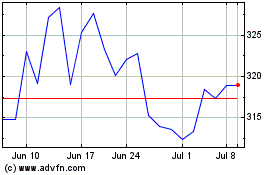Eaton Identifies Five Best Practices To Protect IT Infrastructure Against Seasonal Power Problems
August 17 2009 - 11:13AM
Business Wire
In the midst of hurricane season, diversified industrial
manufacturer Eaton Corporation (NYSE: ETN) is sharing best
practices to protect Information Technology (IT) infrastructure and
critical business systems from power disturbances. Many businesses
overlook the risks because it is easy to take IT and power systems
for granted. Eaton offers five practical tips any business can use
to reduce the risks and enhance the reliability of IT
systems.
1. Know your risks: Power outages are
often assumed to be rare and unlikely events but severe weather is
a major threat to power systems; three of the top five most
significant outages reported in 2008 were caused by Hurricane Ike,
Hurricane Gustav and tropical storm Hanna. These storms affected
approximately five million people according to Eaton’s Blackout
Tracker (www.eaton.com/blackouttracker),
an award-winning online tool that provides a snapshot of reported
power outages across North America. With this interactive site,
visitors can see the cause, duration and number of people affected
by a blackout and view causes per state or region.
2. Consider your investments: Even a
small server configuration and local area network (LAN) represents
an investment of tens of thousands of dollars. To that, add
applications, management systems and critical databases, and it is
clear that significant company assets depend on power that is not
always dependable. Eaton’s Blackout Tracker Annual Report cataloged
more than 2,000 U.S. power outages in 2008.
3. Power problems are equal-opportunity
threats: Computers, servers and networks are just as critical
to a small business as a data center is to a large enterprise. In
addition to severe weather, equipment failures, lightning, copper
thieves, even wayward snakes can cause power disruptions that have
the potential to bring business to a halt. Look beyond generators
and surge suppressors and consider an uninterruptible power system
(UPS).
4. Treat any IT equipment location as a
data center: In small to medium-sized businesses the rack
environment may be the data center, but when planning this
environment it is still important to consider the same logistics as
in a large data center: access control, thermal management, power
protection, power distribution, cable management, flexibility and
monitoring.
5. Determine the level of power protection
needed: Consider what type of UPS, best deployment strategy and
how much UPS capacity is required for your business. Assess how
much battery power you need to shut down systems or switch to
backup generators in case of an emergency. If an outage extends
past the limits of backup systems, power management software can
orchestrate the selective, sequential shutdown of loads to extend
available battery backup time.
A comprehensive power protection plan should not only
address power failure, but also other problems such as power sags
and surges, line noise and frequency variation. Eaton offers a
variety of devices that can protect IT equipment against the
inherent unreliability of utility power. UPSs and generators
represent the most common power protection devices to protect data
and equipment.
To access the Eaton Blackout Tracker or request a copy of
the 2008 annual report, visit
www.eaton.com/blackouttracker. Eaton will
continue to track all named storms throughout 2009. To learn about
Eaton’s power quality products, visit
www.eaton.com/powerquality.
Eaton’s electrical business is a global leader in power
distribution, power quality, control and industrial automation
products and services. Eaton’s global electrical product lines,
including Cutler-Hammer®,
Moeller®,
Powerware®,
Holec®,
MEM®,
Santak®, and MGE Office
Protection Systems™ provide
customer-driven PowerChain Management®
solutions to serve the power system needs of the data center,
industrial, institutional, government, utility, commercial,
residential, and OEM markets worldwide.
Eaton Corporation is a diversified power management
company with 2008 sales of $15.4 billion. Eaton is a global
technology leader in electrical components and systems for power
quality, distribution and control; hydraulics components, systems
and services for industrial and mobile equipment; aerospace fuel,
hydraulics and pneumatic systems for commercial and military use;
and truck and automotive drivetrain and powertrain systems for
performance, fuel economy and safety. Eaton has approximately
70,000 employees and sells products to customers in more than 150
countries. For more information, visit
www.eaton.com.
Eaton (NYSE:ETN)
Historical Stock Chart
From May 2024 to Jun 2024

Eaton (NYSE:ETN)
Historical Stock Chart
From Jun 2023 to Jun 2024
